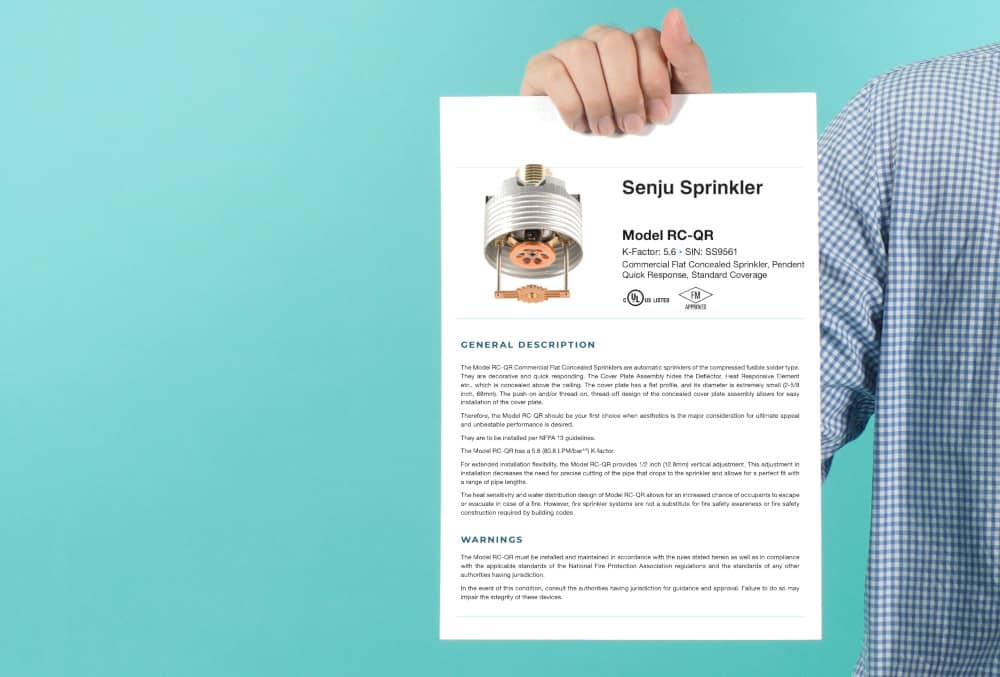Understanding Senju sprinkler data sheets makes IDing and ordering the correct parts easier
Manufacturers’ fire sprinkler data sheets help customers choose the correct products from what can seem like a confusing number of options. And to the unfamiliar, finding the essential information can be challenging. This blog attempts to demystify that process for Senju sprinkler data sheets.
Senju Sprinkler, Japan’s best-selling manufacturer of fire suppression products, is known for selling a range of affordable, reliable, and good-looking sprinklers and accessories for both residential and commercial applications. Understanding these parts is crucial for proper selection, maintaining compliance with NFPA requirements, and meeting your system’s fire protection needs.
Senju data sheets provide the information installers and buyers need. Here is our guide to using them:
- Starting with the SIN—and how Senju organizes its data sheets
- The General Description and Warnings sections of Senju data sheets
- Technical Data and fire sprinkler “approvals”
- Design Criteria—and why there’s more detail on residential sprinklers
- The Operation, Installation, and Care & Maintenance sections
- The Order Procedure
Are you in the market for fire protection equipment? QRFS carries a large selection of Senju sprinklers, concealed cover plates, and escutcheons. If you know the sprinkler ID number, try using our QRFS Quick Finder—it’s a quick and easy way to identify and buy the right parts online.
Starting with the SIN—and how Senju organizes its data sheets
All listed fire sprinklers made after 2000 have a SIN displayed on their deflectors corresponding to an exact manufacturer and model—except certain Senju sprinklers.
Some of the company’s uniquely designed sprinklers, like this flush pendent, instead have the Model designation printed on their distinctive ends (deflectors). The SIN, along with other markings, is on the base of the sprinkler near the threads. This isn’t very convenient since you’d have to drain the system and remove those sprinklers to see their SINs.
But—since there is only one SIN within that series, we know it: in the linked example above (and picture below), the deflector says “ZN-RES,” so we know it’s an SS421.
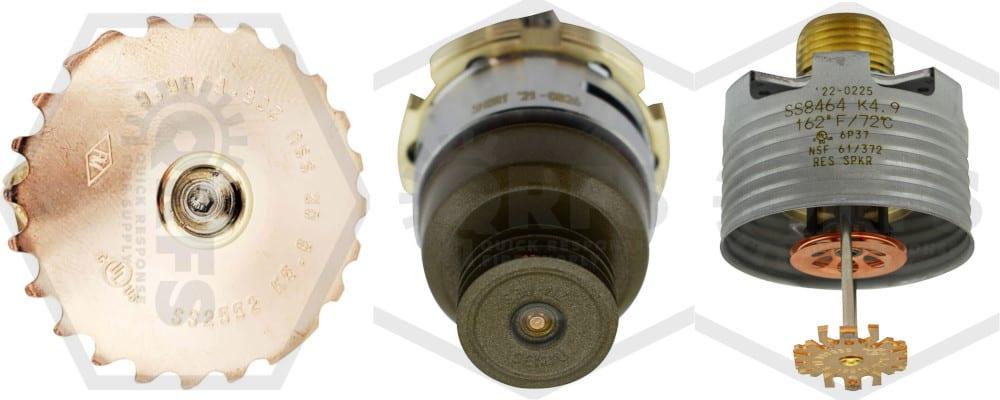
Senju’s alphanumeric code always begins with “SS” followed by several numbers.
Each SIN represents a combination of specific sprinkler characteristics, including:
- K-Factor, which is the orifice size that helps determine how much water flows and how quickly
- Response type: quick response, standard response, or residential (fast response)
- Orientation: pendent, upright, or sidewall
- Maximum working pressure, measured in psi (pounds per square inch)
If a sprinkler differs by any of those characteristics, guidelines from the International Fire Suppression Alliance (IFSA) require a different SIN. So, for example:
- The SS4421 is a Senju residential (fast response) pendent sprinkler with a 2 K-Factor.
- The SS2551 is a Senju quick response pendent sprinkler with a 6 K-Factor.
This clear identification is essential because fire protection standards require sprinklers with precise performance characteristics for a building and system and (mostly) exact matches between heads and their standard accessories, like cover plates, escutcheons, and head guards.
When installing new fire sprinklers, you want the heads specified by the system designer. And when replacing sprinklers, the first step is to match the exact sprinkler via the SIN. If that’s not possible—say, a sprinkler is old—you’ll need a replacement with the same or very similar performance characteristics (response type, orientation, K-factor, activation temperature, etc.). A fire protection pro should be involved in finding a new head.
As with every sprinkler, Senju’s SIN does not specify the temperature or the finish, so it will not identify an exact match. You’ll still have to choose the characteristics that match your previous sprinkler and system requirements from there.
How Senju organizes its data sheets
Some manufacturers publish data sheets that cover one SIN, while others feature multiple SINs within the same model line. Senju does the latter, but in their case, that often only means one distinct SIN—sometimes two based on different orientations—per sheet and model designation.
The top of a Senju sprinkler data sheet has a picture of the head with its model designation and SIN, among other basic characteristics and a summary of listings.
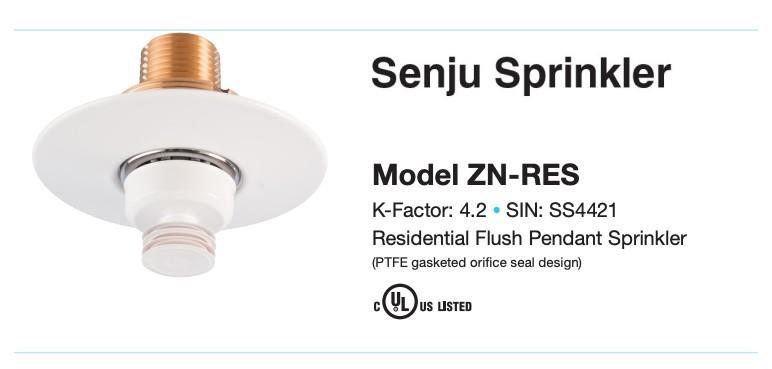
The General Description and Warnings sections of Senju data sheets
In addition to the essential info in the data sheet’s header, Senju uses the “General Description” portion to cover the sprinkler’s applications, including the system and occupancy type. For example:
- The Model FR-QR pendent and upright sprinklers’ data sheet specifies for use in “light or ordinary hazard commercial occupancies.”
- The Model RC-RES residential lead-free concealed pendent specifies “wet pipe residential sprinkler systems” such as “homes, hotels and other living quarters.”
- This section discusses the relevant NFPA installation standards: NFPA 13, 13D, 13R, or a mixture of them.
The General Description section also lists some related parts necessary for a proper installation—escutcheons and cover plates. But this info is also found elsewhere on the data sheet, and it may seem unclear on different documents.
For example, Senju’s data sheet for the Model FR-QR explicitly says it needs D1 or D2 escutcheons. But while the sheet for the concealed Model RC-RES describes the cover plates and their adjustments, it doesn’t specify a code for the correct covers. Never fear; it’s pretty simple: Senju designates the matching covers by the first two letters of the model name. So, Model RC-RES sprinklers use RC cover plates.
Otherwise, the General Description section can vary a bit. In some data sheets, usually for residential sprinklers, there is more information about performance characteristics, uses, and adjustment ranges. So, read it all!
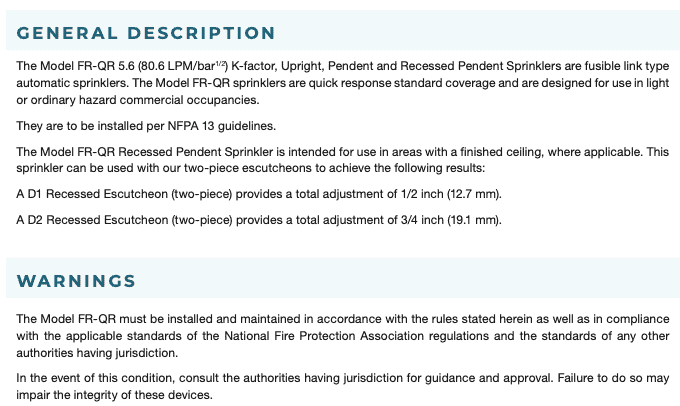
The General Description is followed by a “Warnings” section outlining standard precautions and disclaimers basically pertaining to all fire sprinklers.
Anyone familiar with fire protection knows these well: follow NFPA rules for installation and maintenance, contractors should provide system owners with documentation, and always defer to the authority having jurisdiction (AHJ) over the system. But just because these warnings are standard doesn’t mean they aren’t important!
Technical Data and fire sprinkler “approvals”
The “Technical Data” section of the Senju fire sprinkler data sheets is where you’ll find a more comprehensive list of information about the sprinkler’s approval/listings, the maximum working pressure, K-factor, temperature ratings, adjustment ranges, and available finishes for compatible cover plates and escutcheons.
It’s really the ‘meat’ of the data sheet. Everything is listed clearly in simple and effective bullet points, and the series is accompanied by a diagram showing all markings, materials, and measurements:
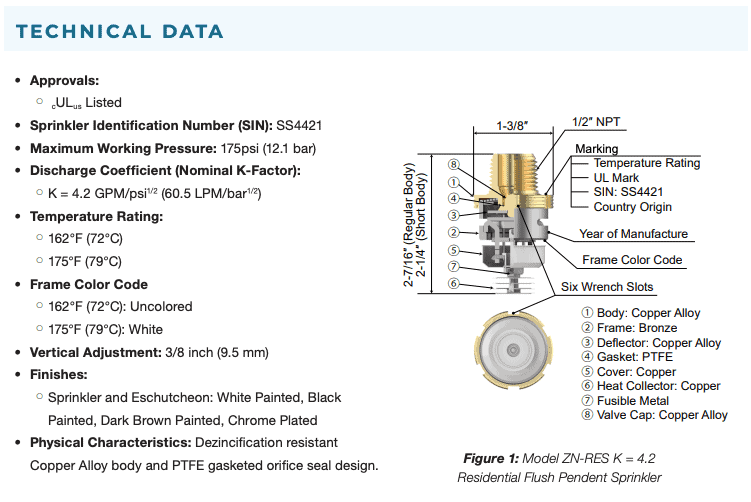
What about listings and approvals?
NFPA standards require all fire sprinklers, cover plates, and many escutcheons to be “listed” by a recognized safety organization. UL and FM Global are two of the most common organizations providing this stamp of approval. Note the “cULus Listed” notation in the Technical Data section of the Senju SS4421 data sheet above—that stands for UL listed in Canada and the US. This info was also in the document’s header.
Some Senju data sheets provide the relevant listings and approvals in those spots. But others get more detailed with a table that covers multiple models, temperatures, and installation types, like this example from the Model FR-QR sprinklers (The pendent SS2551 and upright SS2552):
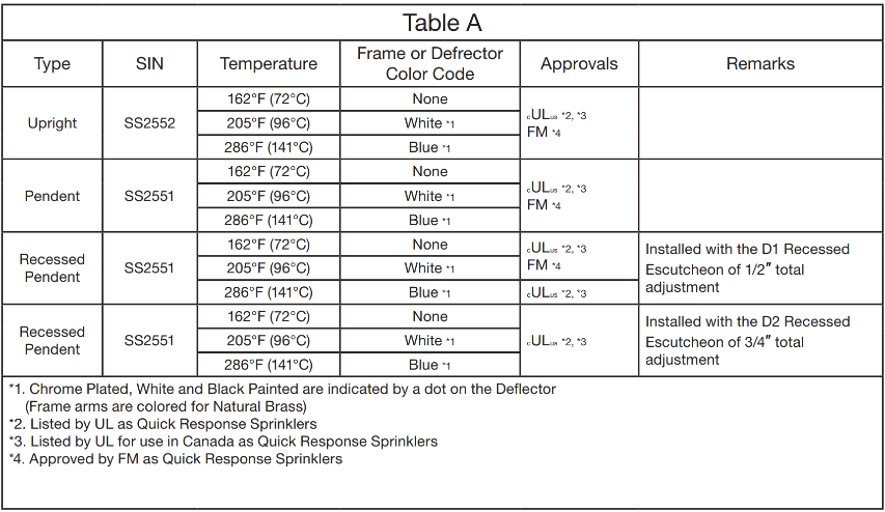
It’s essential to look closely at any tables and their accompanying footnotes to get all the necessary information. When ordering, be sure that the products you choose carry the listings required by your relevant authorities having jurisdiction. For example, a government AHJ will typically be a-ok with a UL listing, but a specific insurance company might require an FM Approval or both.
To learn more, check out our blog explaining fire protection listings and approvals.
Design Criteria—and why there’s more detail on residential sprinklers
If you were to view two Senju fire sprinkler data sheets side-by-side, one for a residential sprinkler and one for a commercial head, the main difference is a much more detailed section on design criteria in the residential document.
For example, the Design Criteria section for the previously mentioned SS4421 residential sprinkler is two pages long and includes a detailed table. In contrast, the corresponding section for an SS2531 commercial sprinkler covers only a page, with minimal notes and language referring to NFPA 13, the commercial installation standard.
This is because NFPA 13 provides detailed rules for fire sprinklers and their installation. But the residential standards —NFPA 13D: Standard for the Installation of Sprinkler Systems in One- and Two-Family Dwellings and Manufactured Homes) and NFPA 13R: Standard for the Installation of Sprinkler Systems in Low-Rise Residential Occupancies—have fewer explicit design criteria.
Instead, NFPA defers to the manufacturers and listing authorities to provide detailed design criteria and instructions for the residential heads.
So, Senju and other manufacturers include this additional information in table form on their data sheets. While the commercial sprinkler data sheets cover the basics, the residential ones go much further, specifying criteria for various sprinkler coverage areas at specific spacing, temperature ratings, pressure, and flow, plus the distance from the heat collector to the ceiling.
Here’s an example:
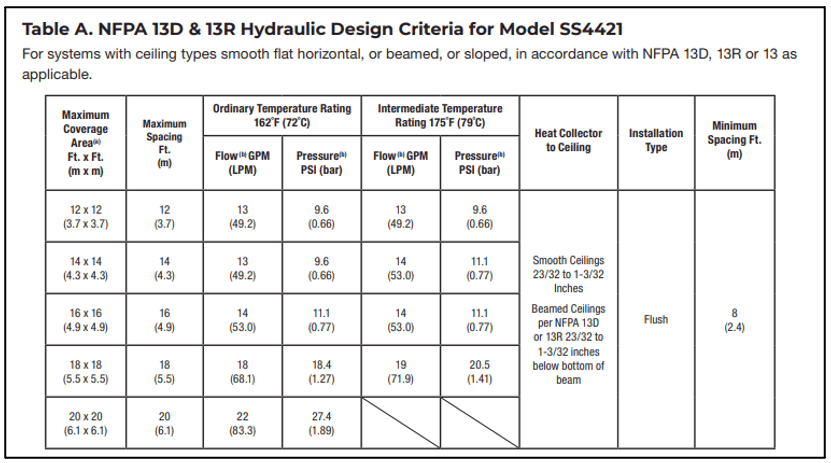
The Operation, Installation, and Care & Maintenance sections
Senju data sheets feature detailed diagrams that are clearly labeled and accompanied by explicit notes. The “Operation” section describes how the sprinkler will react to heat from a fire, along with illustrations of a sprinkler that goes from static to activation.
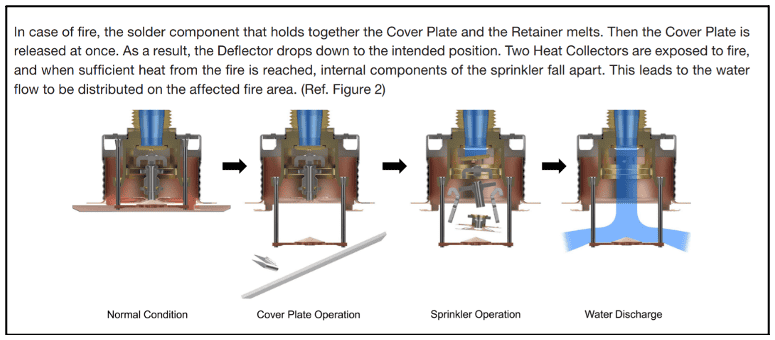
The subsequent “Installation” section has easy-to-follow, step-by-step instructions, supplemented with diagrams showing examples of “Incorrect” vs. “Correct” placement:
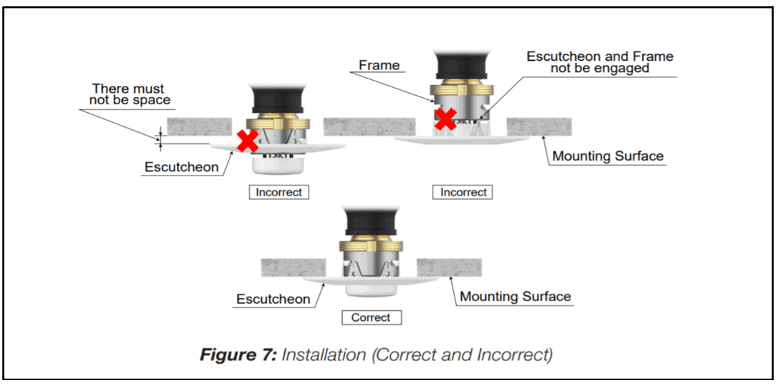
Crucially, the Installation section also specifies what fire sprinkler wrench is compatible with the sprinkler (detailing the wrench’s model/part number). You must have the right wrench to avoid damaging the head, plus keep a spare on hand to comply with NFPA standards. (And don’t worry, this information is also elsewhere in the document.)
Then there is the “Care & Maintenance” section, which essentially restates many major rules from NFPA 25: Standard for the Inspection, Testing, and Maintenance of Water-Based Fire Protection Systems governing commercial sprinklers—plus adds a few. Most residential sprinklers aren’t officially governed by NFPA 25, but the same basic prescriptions apply.
The Order Procedure
Finally, Senju has the “Order Procedure” section, which, along with the Technical Data section, provides perhaps the most useful info when you need to buy the right equipment. It restates and consolidates most of the key info in one place:
- The model, SIN(s), K-factor, and available temperatures
- The key matching accessories (wrenches and escutcheons or covers)
- Listings (“Approvals”)
- Available standard finishes
You should be able to confidently pick a sprinkler or accessory and buy it with the info in this section.
Since Senju data sheets usually contain only one or two SINs, ordering off the sheet is more straightforward than with some other manufacturers. Just be sure you know your new or replacement head’s sprinkler ID number, temperature rating, and finish, plus any compatible accessories.
Senju sprinkler data sheets simplify finding the correct parts
Senju packs substantial information about their fire sprinkler heads and associated fire protection parts in relatively concise data sheets. You can find these sheets (and the products they were written for) on QRFS’s Senju fire sprinkler product pages.
We also provide our own comprehensive coverage of Senju details on these pages, including in-depth text overviews, video descriptions, reviews, and helpful blogs. These resources are designed to help you source the right parts, right away.
And if you’d like an even faster way to find a specific Senju sprinkler, escutcheon, cover, or wrench by SIN:
Use the QRFS Quick Finder!
Just enter the sprinkler identification number (SIN), select the options needed, and it shows you the correct parts available for purchase immediately.
Contact us with any questions at 888-361-6662 or support@qrfs.com.
This blog was originally posted at blog.qrfs.com. If this article helped you, check us out at Facebook.com/QuickResponseFireSupply or on Twitter @QuickResponseFS.


